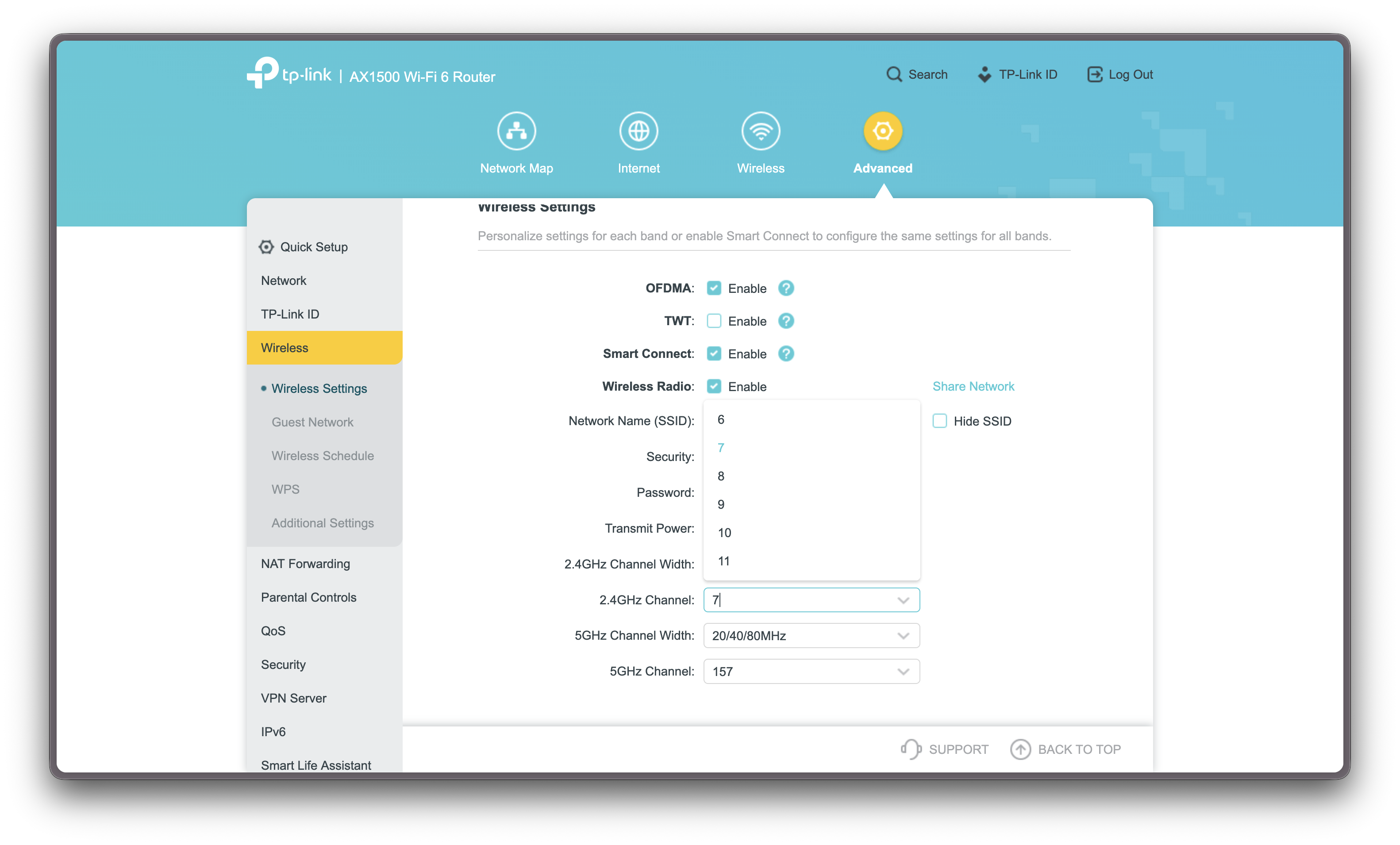Troubleshoot Slow Internet
Updated 10/30/2025
Have you noticed alot of buffering and long load times when you go to watch a video? This guide is for you. In this tutorial I will showcase the major hurtles involved with wi-fi conectivity and give you the tools to check your own connection for potential problems.

What to check for?
There can be some basic things to first evaluate when troubleshooting
- When was the last time the router was restarted?
- What sort of internet speeds are you getting standing close to the router?
- What sort of speeds are you getting far away from the router?
- What channels are in use by 2.4 and 5Ghz?
These are the common checks we will go over today, I will not claim to say this is all it could be however. Wireless internet can be an illusive beast at times.
Restarting your Router
This is the first most basic check anybody can do. Just walk up to your router and unplug it for 10 seconds. Then plug it back in. Take note of the color your lights are before you turn it off. Then compare once it’s back on to see when the boot process has finished and it has returned to normal. Typically the lights on the front of the router indicate something for you. Take note of this router here.

As you glance at these status lights take note of what they could mean. The power light more than likly indicates power, whereas the 2 status lights showing the traditional wi-fi symbol most likly represent wi-fi. Then from there is does admittedly get somewhat confusing but here it is, the Planet symbol is for Internet conectivity, so while your router may be powered on, you may even be connected to wi-fi, but if that light is not on you will never reach Google or Facebook. Then the remaining status lights show you if ethernet devices are connected onto the back of your router, if you don’t know if you have ethernet devices attached, you don’t.
Running a speed test
Running a speed test on your network will be the first thing we ask you to do when troubleshooting how fast your connection is. Learning how to measure your current internet speed can be a very valuable tool to ensure you are always getting what you pay for.
Many speed test websites exist and below I will link some of my favorites. It can be helpful to compare from different sources. Keep in mind some speed test providers have better infastucture than others, speedtest.net by Ookla is an industry standard that is built in to many third party speed test tools such as Roku’s. To test it out try visiting the website speedtest.net and press the “Go” button to run a speed test on your network

As you run the speed test you will see a measurment of your speed in Mbps or MegaBits Per Second , you can reference this number against the plan you are on with us, which garnetees the delivery of a certain threshold of speed.
Keeping in mind your average video stream takes around 10Mbps of bandwidth to play at full quality without buffering. If your speeds are well below 10Mbps then there could be possible issues with your connection. Also note that upload speed is only used when your device requires to send something to someone else, which in networking does not happen often, so while your upload speed will be much power than your download in the real world that will not matter.
Checking what channels are in use
Imagine your Wi-Fi as a group of invisible “roads” in the air that your devices use to talk to your internet box. These roads are called wireless channels, and they live inside two neighborhoods — 2.4 GHz and 5 GHz. The 2.4 GHz neighborhood is older and busier — lots of devices like baby monitors, microwaves, and your neighbors’ Wi-Fi use it too. Because there are only a few roads here, everyone sometimes bumps into each other, making things slow. The 5 GHz neighborhood, on the other hand, has way more roads and less traffic, so it’s usually faster — but it can’t go as far or through as many walls. If your Wi-Fi feels slow, your neighbor’s router might be “driving” on the same channel as you. Luckily, there are tools to help you find a clearer road. On a Mac, you can use an app called NetSpot to see what channels nearby networks are using. On Android, an app called WiFi Analyzer does the same job. And if you’re on an iPhone, Apple hides a Wi-Fi scanner inside the old AirPort Utility app — even if you don’t own an AirPort device, it still works great for finding the best channel to use. Here is a screenshot from the Mac Application NetSpot

As you can see you are able to view which channels your neighbors are using and make an educated decision of what channel to move your network onto. Once you find the proper channel in order to switch it you will need to login to your rouuter, if you are unfamiliar with that we have a great guide on this site on how to setup your wifi router which covers that topic. As a general rule you will want to navigate to your default gateway from a web browser and 99% of the time on a TP-Link router your default gateway will be http://192.168.0.1/ or on a Netgear typically it will be http://192.168.1.1 and if it is not any of those, inside almost every wi-fi settings menu it will show you a default gateway. You could also from a Windows Command Prompt type in ipconfig and read in the output where you find default gateway, or on any MacOS or some Linux distros you can run ifconfig to get your default gateway.
Once you are able to navigate to your default gateway inside a web browser and log in. You should be on this main menu (different TP-Link models may look slightly different, generally it will follow the same steps) click into the Advanced section from the top or side menu,
You will want to look for the option that says Wireless → Wireless Settings , from that point you should see the option for 2.4Ghz and 5Ghz manual channel selection.

Conclusion
Wi-Fi problems can feel like magic tricks gone wrong — one moment everything’s smooth, and the next your video won’t load. But as you’ve seen, most of these issues have simple explanations and even simpler fixes. Restarting your router clears up temporary hiccups, speed tests show you what performance you’re actually getting, and checking your wireless channels helps you spot neighborhood interference that could be slowing you down. With a few free tools like NetSpot, WiFi Analyzer, or Apple’s hidden AirPort Utility scanner, you can quickly see what’s going on behind the scenes and make smarter choices about your setup. The goal isn’t to become a network engineer — it’s just to understand enough to take back control of your Wi-Fi and make sure your connection is working as fast and reliably as it should.

